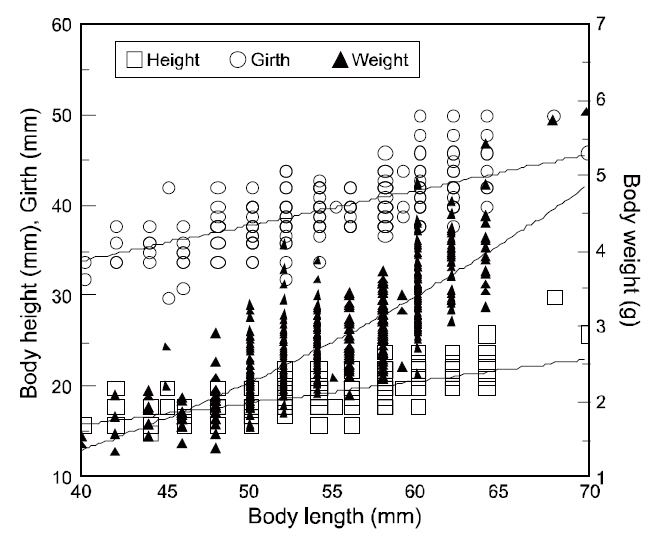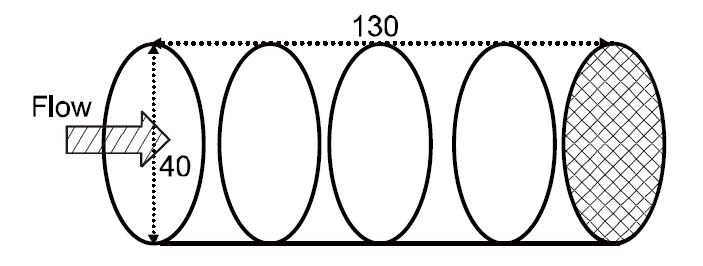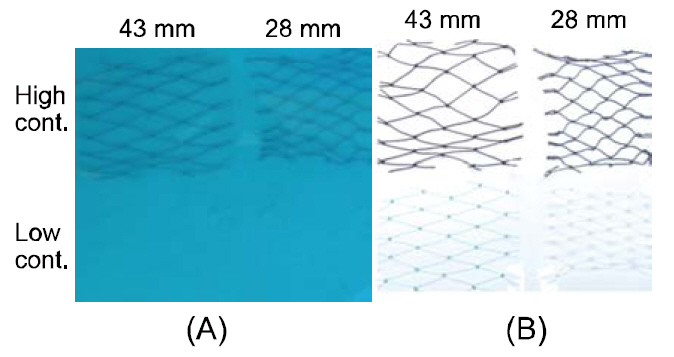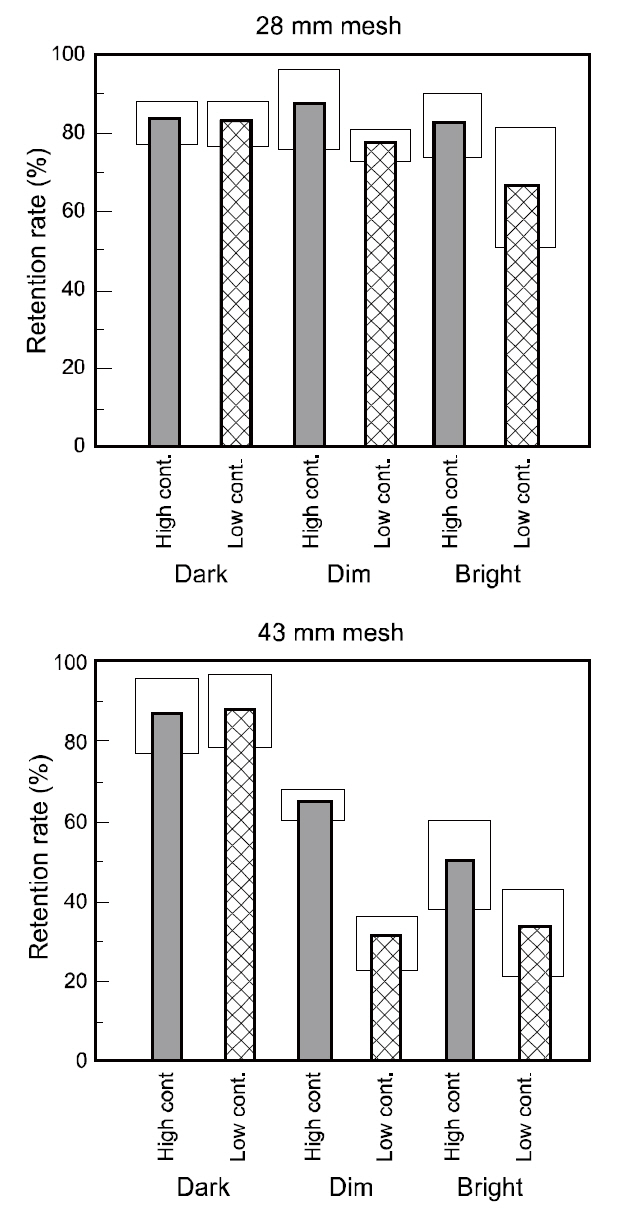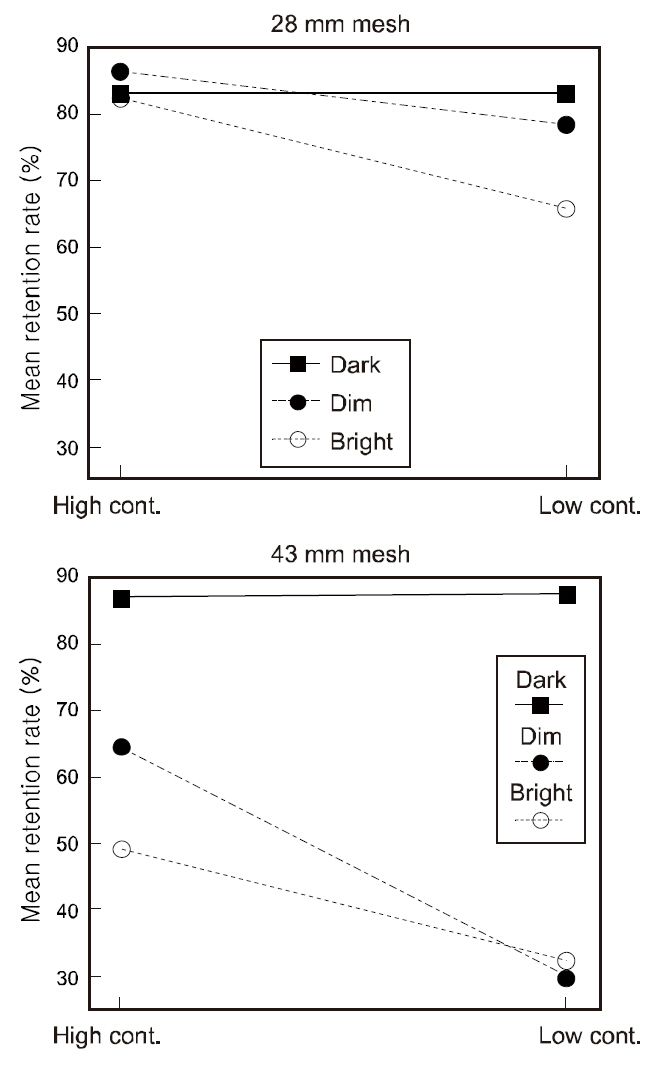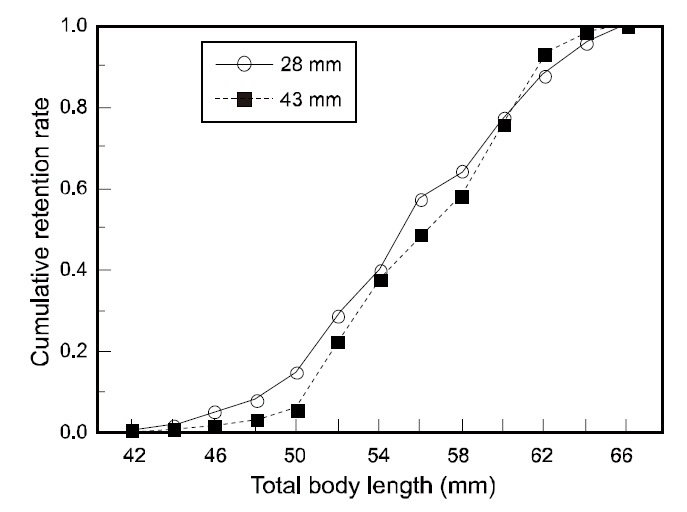



Visual stimuli of nets, which affect fishing selectivity, vary by twine diameter, color, and material under different light conditions and visual geometries. In this study, two cylindrical model codends of two mesh sizes, 28 and 43 mm, were made of high-contrast, dark brown polyethylene(PE) netting twine and low contrast, light-blue polyamid (PA) monofilament twine. Each model codend was filled with juvenile seabream and set in the water channel of a light-blue circular tank under a flow speed 0.8 m/s for 30 min. Light conditions were set to relatively bright, dim,and dark. The resulting retention rates of juvenile seabream were 15-35% lower for the lowcontrast codend with PA monofilament than for the high contrast PE twine netting under bright and dim light conditions, while no difference was observed under dark conditions. The effects of mesh size and netting contrast on the retention rate were dependent on the light level, while the retention rate due to netting contrast was independent of mesh size. Therefore, low-contrast nets in the codend could help to reduce juvenile bycatch by disturbing the orderly optomotor response.
Bycatch and discards, including the capture of juveniles of economically valuable and ecologically important fish, are still of great concern in many fisheries (Chopin and Suuronen, 2009). Management measures to reduce bycatch include fishing gear modifications, the installation of bycatch reduction devices, and other gear-based mitigation technologies. In particular, the selectivity of towed fishing gear can be controlled using, for example, mesh size, mesh shape, codend size, and construction as physical elements in relation to fish behavior patterns as biological factors (Graham et al., 2004).
From field video observations, fish generally maintain their optomotor response in the codend and try to penetrate through a clear path of the netting (Glass and Wardle, 1989; Wardle, 1993; Kim and Wardle, 2003). Fish escapement has been shown to be higher when fish make more approaches to the mesh net as an erratic reaction rather than maintaining their positions as an optomotor response (Kim et al., 2008). The optomotor response of fish needs clear visual cues as fixed visual objects to maintain relative swimming speeds and directions (Arnolds, 1974). At night or at depths in which the light levels were below the detection threshold of many species, fish often lost the ordered pattern of reaction behavior (Glass and Wardle, 1989; Walsh and Hickey, 1993). Ryer and Olla (2000) also argued that trawl bycatch reduction strategies, which rely upon undersize or nontarget fish using vision to guide them out of the net, may be less effective at night or at depths in which ambient light levels fall below critical levels. Accordingly, the visual contrast or visibility of the net played an important role in fish responses during the capture process (Cui et al., 1991; Kim, 1998; Kim and Wardle, 1998).
The visual stimulus of the net varies by net color in relation to, for example, water color and twine diameter, as well as by the background light level and visual geometry (Kim and Wardle, 1998). The effects of twine thickness on net selectivity or on the escape of fish (Broadhurst et al., 2000) may be the effects of differences in visual contrast and visibility as well as the stiffness of the twine, as observed for haddock in the North Sea (Lowry and Robertson, 1996), fish in the Mediterranean Sea (Sala et al., 2007), and fish in Australian fish trawls (Graham et al., 2009). Differences were also found between single and double codends (Ozbilgin and Tosuno?lu, 2003), although the absolute values of the escape rates varied. Comparison between polyethylene (PE) and polyamid (PA) codends of bottom trawls (Tokac et al., 2004) or seine nets with a piece of PA transparent net partly attached to the wings (Gray et al., 2000) also showed improved selectivity for sand whiting.However, these studies did not mention the effects of net contrast on catch.
From the above results, low visual stimuli such as thin twine, single codends, or PA transparent net enabled higher escapement compared to a higher contrast net due to their less clear visual cues, which led to reduced optomotor responses (Jones et al., 2008; Kim et al., 2008). Observations of juvenile flatfish escapement from a model codend with net contrast as a quantitative visual stimulus were recently reported (Kim, 2011). Therefore, the fundamental hypothesis on the effects of net contrast on fish escapement, especially in a codend, is that a lowcontrast net leads to higher escapement. However, the effects of, for example, light, mesh size, and species on fish escapement were not tested in the water channel experiments or in field observations.
The purpose of this study was to clarify the effects of light and mesh size with codends of different contrasts. Two model codends were made from highcontrast PE netting or low-contrast PA netting with two mesh sizes. The responses of juvenile red seabream (
About 3,000 (group A) and 3,500 (group B)individuals of juvenile red seabream about 3 months old were purchased from fish hatcheries in Tongyoung and Geoje, Korea, on May 23 and June 23,2009, respectively. The body sizes of 500 sampled fish were 5.3±0.5 cm in mean total length, 4.0±0.3 cm in mean body girth, 1.9±0.2 cm in mean body height, and 2.9±0.8 g in mean body weight (Fig. 1).
Fish were reared in the 3-m-diameter central part of a 5 m-diameter circular tank enclosed by acrylic boards 1.5 m in height and blue in color, with fiberreinforced plastic, as used by Kim and Whang (2010). Fish were fed on aquaculture pellets once a day. Seawater in the tank was filtered through 300 L of sand and the seawater was changed every 15 days.Water temperature varied from 20°C to 24°C during
May 23-July 10, 2009, and the salinity was 33-34 psu during the experiments. Experiments were carried out in accordance with Korean law for the ethical use of animals in research.
Each model codend (reef knot, diamond mesh) was 40 cm in diameter and 130 cm in length with a hanging ratio of 87%, as used in previous experiments (Kim and Whang, 2010). The lateral circumference was framed into circles by five iron wires (0.2 mm Ø) as shown in Fig. 2. For the high contrast net, small-sized (28 mm) mesh was made of dark gray PA (multifilament, thickness 0.5 mm Ø)and large-sized (43 mm) mesh was made of darkbrown PE (monofilament, 0.5 mm Ø). The front and rear round panels were 10-mm mesh white PA Raschel netting (multifilament, 0.5 mm Ø), which did not allow juvenile seabream to pass through.
For the low-contrast net, PA monofilament netting (mono-ply, reef knot, diamond mesh) was used, with the 28-mm mesh size made of 0.5 mm Ø white transparent netting twine and the 43 mm mesh size made of 0.5 mm Ø light green netting twine, as shown in Fig. 3, against the blue background of the
water tank and a white background in air.
A model codend was set up in the outer channel of the circular water tank (depth 70 cm). Four underwater pumps (IPV-835, 220 V, 1 hp; Hanil Electronics, Seoul, Korea) generated a mean water flow of 0.8 m/s (measured by a Marsh McBirney 201D; Marsh McBirney, Frederick, MD, USA). The illumination of the water tank, which was located at an outdoor site, was controlled by covering the tank with black canvas to achieve bright conditions of 100.3±10.6 lx and dim conditions of 1.1 ± 0.2 lx as measured by an underwater illumination meter (Topcon IM-5, Tokyo, Japan) in daytime and dark conditions (estimated as <0.00001 lx) at night. The vertical absorption coefficient and beam attenuation coefficient of the seawater in the tank were measured using an AC9+ (Wet Lab) transmission meter, as described in Kim and Whang (2010).
For each experiment, a group of 200 fish was released from a vinyl bag into the water flow at the front of the codend. Fish behavior was observed
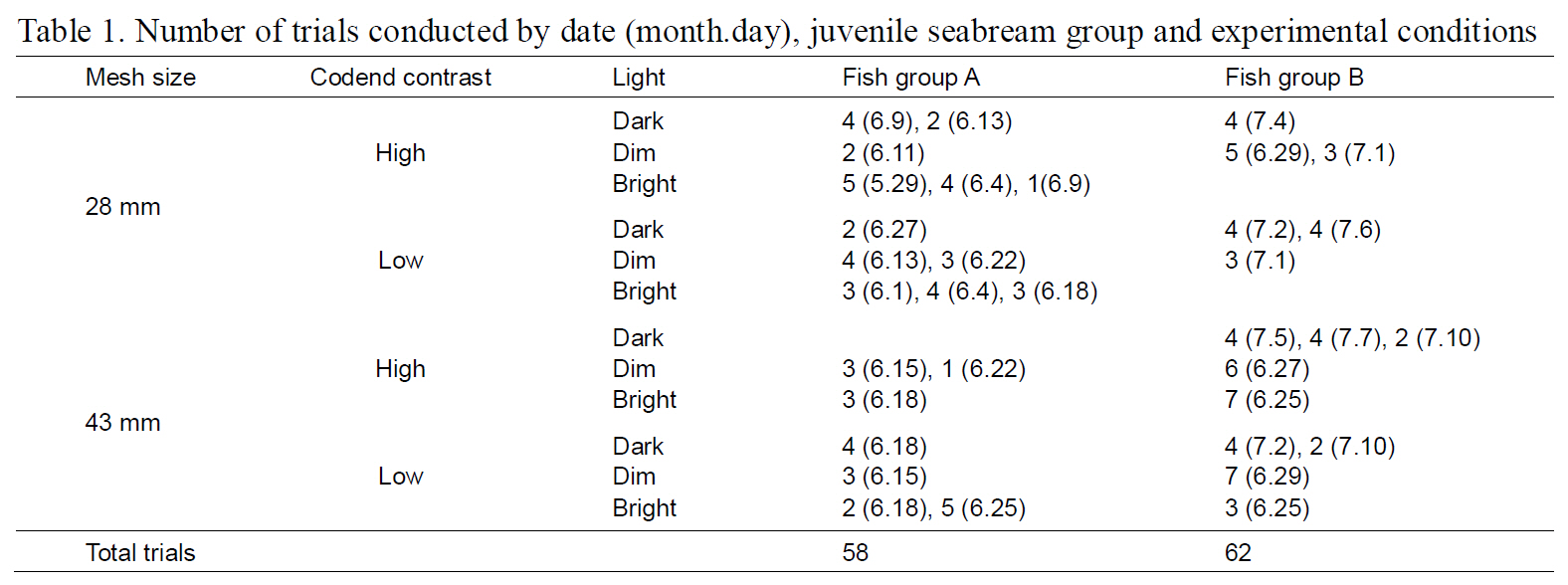
Number of trials conducted by date (month.day) juvenile seabream group and experimental conditions
using underwater video cameras (Simrad OE 1210,Huhu UWC-150VH-N) and was recorded on videotape for 30 min. Then, fish retained in the codend were removed to a resting water tank for counting. Each experiment combined two contrasts of net, two mesh sizes, and three brightness conditions and was repeated 10 times for random groups of fish separated by at least 2 day intervals as shown in Table 1. The numbers of fish retained were compared by three-factor (two codend types, two mesh sizes, and three light levels) analysis of variance (ANOVA) and paired
The inherent contrast in relation to the apparent contrast of netting varies with factors including luminance, attenuation coefficient, reflectance, twine diameter, and zenith angle with light wavelength (Kim and Wardle, 1998). The inherent contrasts of the nets used in these experiments were estimated from Kim and Wardle (1998) to compare visual stimuli under a beam attenuation coefficient of 1.369, a vertical absorption coefficient of 0.591, and a zenith angle of 90°. The estimated values of netting in the experimental codends were 1.12 in dim light and 1.38 in bright light for the high-contrast PA gray and PE brown netting twine (0.5 mm Ø), and 0.34 in dim light and 0.41 in bright light for the low-contrast PA light-green and white transparent monofilament netting twine (0.5 mm Ø).
The mean±SD retention rates of juvenile seabream in codends made of high- or low-contrast netting of 28- and 43 mm mesh size under three light conditions

The mean retention rate (%±SD) of juvenile seabream in the conventional high-contrast PE codend and low-contrast PA netting with two mesh sizes and three light conditions
are presented in Table 2.
The comparisons of retention rates ±SD between conventional high-contrast PA or PE codends and low-contrast PA codends in relation to light conditions and mesh size are shown in Fig. 4. Retention
rates were generally lower for 43 mm mesh nets or under brighter conditions than for 28 mm mesh nets or under dark conditions. The mean retention rates of low-contrast nets under dim or bright conditions were significantly (
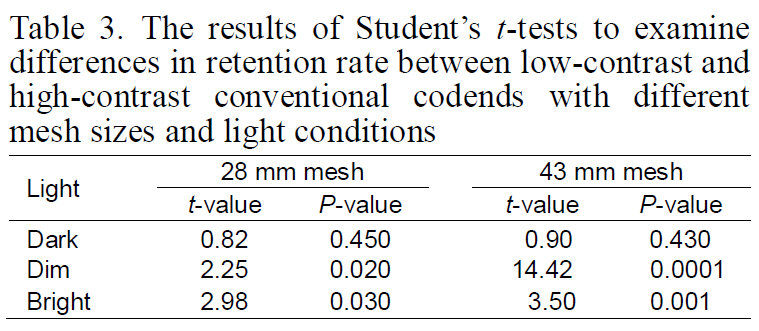
The results of Student’s t-tests to examine differences in retention rate between low-contrast and high-contrast conventional codends with different mesh sizes and light conditions
The escape rates of up to 35% from the lowcontrast codend constructed of green PA in this study was similar to rates revealed in a field experiment by Tokac et al. (2004). The escape rates of seabream and red mullet from Turkish bottom trawls using PA 36 mm mesh (Tokac et al., 2004) were estimated to be 13-37% higher than from PE 40 mm mesh, although the color of nets and turbidity of the water were not mentioned in the estimation of contrast. In an Australian lagoon, seine nets with a piece of PA transparent net attached to the wings (Gray et al.,2000) showed improved selectivity in 50% retention of body size for sand whiting due to differing escape responses to visual cues. However, the above effect of net contrast was not expected under dark conditions of night or deeper water. The clear path effect achieved by low-contrast netting was confirmed in our study, although the color of the net, fish species, and light conditions were different in the present study than those in Tokac et al. (2004) or Gray et al. (2000).
The turbidity of the seawater used, measured as vertical and beam attenuation coefficients, was slightly higher than the inshore waters of Tongyoung. The horizontal contrast transmission of the seawater used in this study was estimated to have decreased by 45% per 1 m when the beam attenuation coefficient was 1.369 and the vertical absorption coefficient was 0.591. Therefore, the low-contrast net was viewed by fish eyes in relation to their visual acuity (Shiobara et al., 1998) as a less visible object that was easily lost for the maintenance of swimming speed and direction as an optomotor response (Arnolds, 1974). The weak optomotor responses of the fish led them to break their ordered swimming patterns and may have allowed for the high possibility of approaches to the side net wall. More approaches to the side net of the codend have been confirmed to result in more escapement (Jones et al., 2008; Kim et al., 2008). Low-contrast netting was also regarded as less visible,
The results of the comparison of fish retention rates by three-factor (two contrasts of codend, two mesh sizes, and three light levels) ANOVA are shown in Table 4. The retention rates of juvenile seabream varied significantly with net contrast, mesh size, or light level as each factor. The findings demonstrated that lower contrast, larger mesh size, or brighter conditions could lead to a higher escapement of juvenile seabream. Furthermore, the retention rates of juvenile seabream by light level were dependent on either net contrast or mesh size, while the retention rates of juvenile seabream by net contrast were independent of mesh size. Therefore, the effects of net contrast on the retention rates of seabream were closely related to light level as a visual factor, but were not related to mesh size as a physical factor.Generally, walleye pollock become entrained or struck in the meshes of trawls under dark conditions (Olla et al., 1997; Ryer and Olla, 2000). Fish could lose their swimming position in the flow in darkness or with invisible nets and then frequently reach the

Results of analysis of variance for retention rate by three factors on mesh size codend type and light from data in Table 2
mesh by chance. The entraining or striking of fish on the mesh could affect escapement (Jones et al., 2008;Kim et al., 2008). However, the retention rate of juvenile seabream was dependent on the interactions among net contrast, light level, and mesh size.
The relationship between the mean retention rate and net contrast of the codend can also be illustrated by mesh size and light level, as shown in Fig. 5. In conclusion, the retention rate of juvenile seabream was significantly lower in the low-contrast net than in the high-contrast net, and its effect was greater for the large mesh size, except under dark conditions.Furthermore, the retention rate was generally lower under bright-light conditions than under dark conditions due to the visual stimulus and visual ability of the fish.
Thinner twine also has less contrast than thicker twine (Kim and Wardle, 1998). The escape rate from thin twine in the codend was shown to be about 8% higher than that from thick twine for haddock in the North Sea (Lowry and Robertson, 1996), about 20% higher for fish in the Mediterranean Sea (Sala et al., 2007), and about 30% higher for fish in Australian fish trawls (Graham et al., 2009). Escapement was also found to be 12% higher from single codends than double codends (Ozbilgin and Tosuno?lu, 2003), although the absolute values of the escape rates varied. The effects of twine thickness on net selectivity or on the escape of fish (Broadhurst et al.,2000) may be the effects of differences in the stiffness of mesh between PA and PE netting twines (Tokac et al., 2004), as well as the increase in net contrast with increasing diameters of netting twine of the same color (Kim and Wardle, 1998). Therefore, the results of our experiments using the same thickness of twine clearly confirmed the increased escape of juvenile fish from low-contrast netting twine nets because its low visual stimulus makes clear paths for fish to follow, as shown in experiments using square-mesh windows or larger mesh sizes (Wardle, 1993).
The cumulative retention rates of juvenile seabream in 28- and 43 mm codends in relation to 2 mm intervals in total body length are shown in Fig. 6. The selection curve of body length was significantly different between the two mesh sizes, as shown by a paired
The results of fish escape behavior experiments from codends in the North Sea showed that more strikes or approaches to nets yielded more escapes
(Jones et al., 2008; Kim et al., 2008). Fish exhibiting approaching or striking behavior are showing more erratic responses than fish displaying the optomotor response of swimming speed and position maintenance (Wardle, 1993; Kim and Wardle, 2003). Increasing erratic responses and reducing optomotor responses could encourage fish to approach the netting and thus to escape from the codend. Therefore,the low-contrast netting used in these codend experiments could help reduce juvenile bycatch by reducing the optomotor response and providing a clear path in combination with an active stimulating device (Kim and Whang, 2010).
The diameter of the model codend was 40 cm, 7.5 times the total length of juvenile seabream, and considered to be a quarter-scale codend. The dimension of the model codend was considered by its ratio relative to fish size, although codend circumference effects on selectivity were investigated by O’Neill et al. (2008) and Broadhurst and Millar (2009). The water flow velocity of 80 cm/s in the experimental tank was 15 times the total length of juvenile seabream and was considered to be half or less of the real towing speed. The experimental codend size and flow velocity were reasonable with respect to juvenile fish size considering that their swimming speed is more than 20 times their body length (Videler, 1993) and that less than 10% of fish were exhausted after 30 min.
In conclusion, our experiments showed the effect of net contrast on juvenile seabream escapement by interactions among net contrast, light level, and mesh size and indicated the higher possibility of low bycatch when using low-contrast net in the codend.Further study of low-contrast nets using full-scale codends should be conducted in field operations with consideration of the scale effects of the fish species and light levels.
